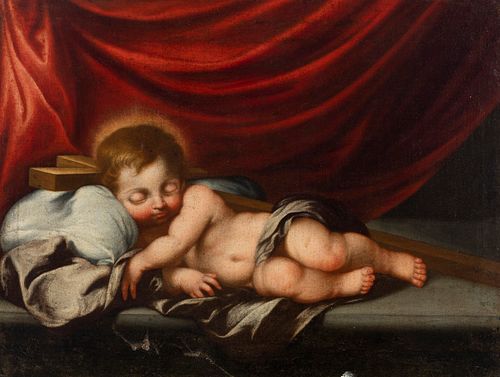Sevillian school of the late seventeenth century. Follower of BARTOLOMÉ ESTEBAN MURILLO (Seville, 1617 - Cadiz, 1682). "Sleeping child with attribute
Lot 58
About Seller
Setdart Auction House
Carrer Aragó 346
Barcelona
Spain
Setdart Subastas was born in 2004 and is currently the first online art auction in Spain with solidity, prestige and reliability guaranteed by our more than 60,000 users. Setdart has a young, dynamic and enterprising team ready to successfully manage the purchase and sale of art works through custom...Read more
Estimate:
EUR€5,000 - EUR€7,000
$5,208.33 - $7,291.67
Absentee vs Live bid
Two ways to bid:
- Leave a max absentee bid and the platform will bid on your behalf up to your maximum bid during the live auction.
- Bid live during the auction and your bids will be submitted real-time to the auctioneer.
Bid Increments
| Price | Bid Increment |
|---|---|
| EUR€0 | EUR€10 |
| EUR€200 | EUR€25 |
| EUR€500 | EUR€50 |
| EUR€1,000 | EUR€100 |
| EUR€3,000 | EUR€200 |
| EUR€5,000 | EUR€500 |
| EUR€10,000 | EUR€1,000 |
| EUR€20,000 | EUR€2,000 |
| EUR€50,000 | EUR€5,000 |
About Auction
By Setdart Auction House
Oct 20, 2021
Set Reminder
2021-10-20 07:30:00
2021-10-20 07:30:00
America/New_York
Bidsquare
Bidsquare : OLD MASTERS
https://www.bidsquare.com/auctions/setdart-auction-house/old-masters-7700
Setdart Auction House sofia@setdart.com
Setdart Auction House sofia@setdart.com
- Lot Description
Sevillian school of the late seventeenth century. Follower of BARTOLOMÉ ESTEBAN MURILLO (Seville, 1617 - Cadiz, 1682). "Sleeping child with attributes of the passion". Oil on canvas. Relined. Size: 53 x 70 cm; 62 x 79 cm (frame). In the present work we see how Jesus Child sleeps on the cross between emblems of death or attributes of the future passion. The prefiguration of the Death and the Passion, theme of great acceptance in the baroque aesthetics, was represented in diverse occasions by Bartolomé Esteban Murillo and his followers. As a model of perfection for all other children, the Child Jesus is perennially portrayed as an example of holiness, virtue and love. The canvas follows a common trend in Murillo's paintings of childhood, its function to arouse strong devotional feelings in accordance with Christ's teaching on the innocent faith of children: "Truly I tell you, unless you become like little children, you will not enter the kingdom of heaven" (Matthew 18: 3). (Matthew 18: 3). Of Murillo's childhood and youth little is known, except that he was orphaned of father in 1627 and of mother in 1628, reason for which he passed to be tutored by his brother-in-law. Around 1635 he must have begun his apprenticeship as a painter, very possibly with Juan del Castillo, who was married to a cousin of his. This working and artistic relationship would last about six years, as was customary at the time. After his marriage, in 1645, he began what was to be a brilliant career that progressively made him the most famous and sought-after painter in Seville. The only recorded trip he made is documented in 1658, the year in which Murillo was in Madrid for several months. It may be thought that at the court he maintained contact with the painters who resided there, such as Velázquez, Zurbarán and Cano, and that he had access to the collection of paintings in the Royal Palace, a magnificent subject of study for all those artists who passed through the court. Despite the few documentary references regarding his mature years, we know that he enjoyed a comfortable life, which allowed him to maintain a high standard of living and several apprentices. Having become the first painter of the city, surpassing in fame even Zurbarán, moved his will to raise the artistic level of local painting. For this reason, in 1660 he decided, together with Francisco Herrera el Mozo, to found an academy of painting, of which he was the main promoter. His fame spread to such an extent, throughout the national territory, that Palomino indicates that around 1670 King Carlos II offered him the possibility of moving to Madrid to work there as a court painter. We do not know if this reference is true, but the fact is that Murillo remained in Seville until the end of his life. His works are currently preserved in the most important art galleries in the world, such as the Prado Museum, the Hermitage in St. Petersburg, the Kunsthistorisches in Vienna, the Louvre in Paris, the Metropolitan in New York or the National Gallery in London, among many others.
- Shipping Info
-
In-house shipping available. Please inquire at admin@setdart.com.
-
- Buyer's Premium



 EUR
EUR CAD
CAD AUD
AUD GBP
GBP MXN
MXN HKD
HKD CNY
CNY MYR
MYR SEK
SEK SGD
SGD CHF
CHF THB
THB







